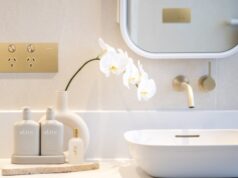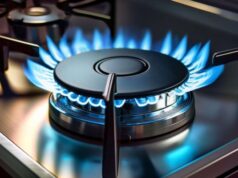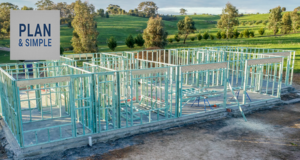
Regulations in Australia restrict the placement of power points in relation to sinks and taps. This article explores what the rules say and how far your power points will need to be from your kitchen sink.
Water is a great conductor of electricity, which can be very dangerous in places like the kitchen, the bathroom or the laundry.
There are certain rules and regulations in Australia that govern how switches and outlets can be placed in relation to water outlets and fixtures.
Knowing them will help you to decide where the safest places to put your general power outlets (GPOs) are when you begin planning the layout of your bathroom or your kitchen. If you have any doubt about where things should go, consult a licensed electrician – they will know these rules all too well and must be employed to do any electrical work.
Bathroom zones
For the purpose of wiring regulations, bathrooms are divided into four zones, in accordance with the Australian/New Zealand Wiring Rules (AS/NZS 3000:2018). These are as follows:
- Zone 0: Inside the bath or shower basin.
- Zone 1: Above Zone 0, extending vertically to 2.5m above the floor.
- Zone 2: Extends 600mm horizontally beyond Zone 1 and up to 2.25m vertically.
- Zone 3: Beyond Zone 2, extending 2,400mm horizontally and up to 2.5m vertically
Testing electrical safety
If you have a handheld shower in your bathroom that has a barrier (like a door or a shower curtain), a good tip to test electrical safety is to test the distance of the water spray when the barrier is in place. If it can reach a power outlet or a switch, then the switch or power outlet probably needs to be relocated.
Zones for positioning electrical fittings in bathrooms with a shower. Left is a shower with a barrier and fixed wall, right is a shower with only a barrier.
Zone wiring regulations for sockets and switches
Where you can place sockets and switches in a bathroom depends on the zone:
- Zone 0: No electrical equipment is permitted, except for equipment specifically designed for use in a bath or shower (for example, low-voltage equipment with appropriate IP rating).
- Zone 1: Only equipment with a minimum IPX4 rating (or IPX5 if subject to water jets) is permitted. Shaver sockets are allowed if they are specifically designed for use in this zone.
- Zone 2: Equipment must have a minimum IPX4 rating. Standard sockets are not permitted unless they are:
- incorporated into a shaver supply unit, or
- Protected by a residual current device (RCD) with a rated residual current not exceeding 30mA.
What are IP ratings?
Ingress protection ratings (or IP ratings) are a system that classifies the degree of protection provided by an enclosure to electrical equipment against solid objects, dust, and moisture.
For this specific use case, here are the required IP ratings:
- Zone 1: Minimum IPX4 rating (protection against water splashes).
- Zone 2: Minimum IPX4 rating; IPX5 if equipment is subject to water jets.
Required RCD protection requirements
All sockets in wet areas must be protected by a residual current device (RCD) with a rated residual current not exceeding 30mA. This is a mandatory safety requirement under AS/NZS 3000:2018.
Kitchen and laundry zones
Slightly different rules apply in other areas of the house, like kitchens and laundries around sinks, basins or other fixed water containers. The distance that electrical outlets (GPOs) can be from a sink is determined by how much water they can contain.
Sinks, basins or other fixed water containers that hold less than 45L have slightly different rules than those that hold more.
For fixed water containers anywhere outside of the bathroom, there are two zones defined:
- Zone 0: The area inside the sink or basin, in which nothing is allowed to be installed.
- Zone 2: Determined by whether or not the container holds more than or less than 45L – no fittings are allowed inside Zone 2.
For containers that hold less than 45L, zone 2 is defined as 0.4m above the top of the container and 0.15m from the edges of the water container. For those that hold more than 45L, it’s 1.0m above and 0.5m from any given side.
Distances to electrical outlets for fixed water containers.
Note that these rules only apply for GPOs – other ‘switches and accessories’ aren’t allowed within 300mm of a fixed water container at all and must be IPX4 rated if they’re to be installed at a distance greater than or equal to 300mm from the fixed water container inside Zone 2. Consult your electrician for exact details.
Safety switches
You can never be too careful where something as volatile as electricity is concerned, especially in a high-risk area like the bathroom. Safety switches monitor the flow of electricity through a circuit and automatically cut the power supply if current is detected leaking from faulty switches or wiring. While they are not a complete guarantee against electrical shocks, they do work to minimise the damage done and could make all the difference.
Since 1992, all new houses in Australia are required by law to have safety switches installed. There are three types of safety switches available:
- Switchboard-mounted safety switches: These are the most basic of safety switches and monitor the fixed wiring and electrical appliances in your household. It is mandatory by law for every home to have these installed by a qualified electrician.
- Safety switches in place of regular power points: These switches replace your standard GPOs and protect any appliances that are plugged into them. They also need to be installed by a qualified electrician.
- Portable safety switches: These can be used both indoors and outdoors and are essential to use if you are using electrical appliances that are not protected by one of the safety switches listed above.
A final caveat
All electrical work in Australia must be done by a licensed electrical contractor, who should properly test any electrical work and supply you with a safety certificate. Licensed electricians can give you personalised advice and ensure compliance with local regulations.
As of May 2025, the National Construction Code (NCC) should be read in conjunction with Amendment 1 of the 2022 edition.





